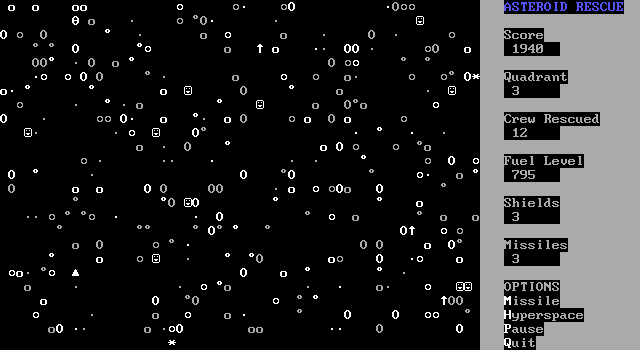Scott Miller had a "new idea" and created Puzzle Fun-Pak and Adventure Fun-Pak out of the best games that had been submitted to Apogee by aspiring authors. Of the four games in the Puzzle Fun-Pak, there are one graphical and three ASCII games. Each of the ASCII games will work on any computer, using a CGA text mode if available, and falling back to Mode 7 for MDA/Hercules cards.
Block Five is the ancient game of Gomoku, in which players take turns placing an X or an O on a 19×19 grid and attempt to get five in a row in any direction. It's basically an enormous game of tic-tac-toe. The game attempts to use Mode 3 whether the player specifies Color or Monochrome (Mode 2 should be used for Monochrome if you have CGA), but the colors are changed to be more readable in grayscale in the Monochrome version.
Asteroid Rescue places you in a ship that must maneuver its way through a dense asteroid field to rescue astronauts. The ship starts with 1000 units of fuel, 10 antimatter missiles and 5 shields. The ship moves forward automatically, and can move only left or right as it passes through the asteroid field. When it reaches the top of the screen, it wraps around back to the bottom. A shield is lost every time the ship runs into an an asteroid, and an asterisk restores one shield. Once the ship runs out of shields, the hull may or may not hold when it hits an asteroid. Missiles can be used to destroy an asteroid in front of the ship (and will not destroy astronauts or power-ups), and an up arrow restores one missile. One unit of fuel is used each time the ship moves forward, and 100 are used when the "hyperspace matter transferral device" is used to randomly jump to another location. A theta (θ) represents a fuel canister with 200 units of fuel stored in it. Once all but one of the astronauts has been rescued, you move to the next quadrant. Each quadrant has two more astronauts than the previous quadrant, starting with six in Quadrant 1.
Phrase Master is a mix between Wheel of Fortune and Hangman. You essentially spin a wheel to determine how much your guess will be worth, but there is no way to go bankrupt or miss a turn, other than guessing incorrectly. Players continue to guess any letter (there is no cost, but also no score for selecting a vowel) until they get one wrong. Like Hangman, both players have a limited number of guesses, starting the game with six. A bonus guess and 10 000 points are awarded to the player who completes each phrase. The game continues until both players have run out of guesses, then the player with the higher score wins. There are 500 phrases in 10 categories, some of which have spelling errors ("Gentleman Prefer Blondes", "General Hostipal", "Princess Diane", and "Raisin Bran Cereral".) The game asks if you have a Color or Monochrome monitor, and sets Mode 1 (40 column color mode) if you choose Color and, curiously, Mode 2 (80 column grayscale) if you choose Monochrome, but still uses only 40 columns, leaving half of the screen blank. Why Mode 2 instead of Mode 0 (40 column grayscale)? As previously mentioned, the game falls back to Mode 7 after failed attempts to set Mode 1/2 if you have an MDA or Hercules card. It seems that the author wrote a 40×25 color version and an 80×25 monochrome version of the game – not just grayscale but truly monochrome for the benefit of Mode 7 users – and it was easier to use the monochrome version in Mode 2 than to make the 40×25 version support both Mode 1 and 0 for the benefit of users who had a CGA graphics card and a monochrome monitor.
Maze Machine is the only game that requires a graphics card, which it uses to generate a maze that is displayed on screen, and can be printed out. The width of the maze can be set from 1 to 159, and the height from 1 to 99. Once the dimensions have been selected, a random number – presumably between 0 and 32768 – generates the maze algorithmically before your eyes. This means that you're unlikely to ever get the same maze twice for any given dimensions, and about 515 801 088 mazes are possible. Taking full advantage of CGA Mode 4, the game randomly selects one of the three colors for the outsize of the maze and another for the walls, allowing for six possible color combinations. Once the maze is drawn, the game switches between the two palettes, and between high and low intensity colors, at random intervals, showing you the maze in four different sets of colors.
Added by DOSGuy
Screenshots
Downloads
Complete version history:
| Adventure Fun-Pak and Puzzle Fun-Pak v1.0 (305,022 bytes) | xxxx | DOS | Play online  |
Availability
Apogee generously released Adventure Fun-Pak and Puzzle Fun-Pak as freeware under the Adventure & Puzzle Fun Packs Freeware License in May 2004. They are both in the same zip file.












